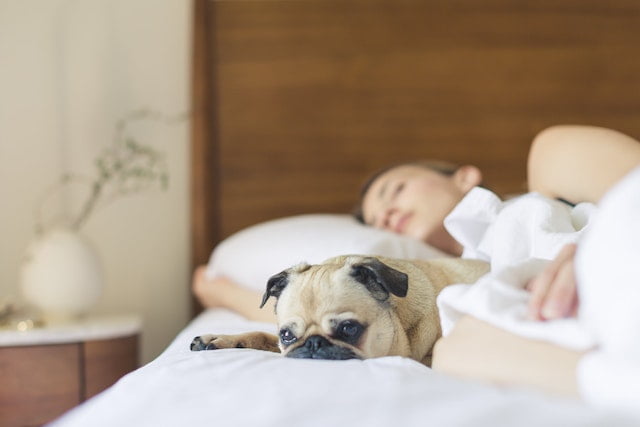Should I crate my dog in the living room or bedroom?
Should I crate my dog in the living room or bedroom? That’s a question I have seen many dog owners ask in pet forums and on social media platforms. I know it’s natural to wonder where the best place is to crate your dog. But, should you keep the crate in the living room or bedroom? Though the answer to this question isn’t always straightforward, but we will try and answer it based on what we’ve gathered and our experience with dogs. In this post, we will discuss the pros and cons of crating your dog in both the living room and bedroom, to help you make the best decision for your pet.
Why is crate training important for your dog?
Before we delve into the specifics of where to place the crate, it’s essential to understand why crate training is vital for your dog. A crate is a safe space for your pet, which can help with:
Housetraining
When dogs are crate trained, they are less likely to have accidents inside the house. By creating a designated space for your dog to rest and sleep, you can establish a routine and reduce the likelihood of your pet going to the bathroom inside.
Separation anxiety
Dogs are social animals, and they can become anxious when left alone. By providing a crate, you are giving your pet a safe space where they can feel secure, reducing the risk of anxiety.
Preventing destructive behavior
Some dogs tend to chew or damage furniture when left alone. By providing a crate, you can keep your dog safe from harmful substances and prevent them from damaging your property.
Is it okay to have the dog crate in the living room?
Yes, it’s perfectly fine to have a dog crate in the living room. In fact, it can be a great way to keep your dog safe and comfortable while still allowing them to be part of the family. Many dogs enjoy having their own space, and a crate can provide a sense of security and privacy. Additionally, having the crate in the living room allows you to keep a close eye on your dog and monitor their behavior. Just be sure to choose a crate that is appropriately sized for your dog and provide plenty of comfortable bedding and toys to keep them occupied.
Pros and cons of crating your dog in the living room
The living room is often the central area of the house, where most of the family’s activities take place. Here are some pros and cons of crate training your dog in the living room:
Pros
- Your dog will feel like part of the family: As social animals, dogs like to be close to their owners. So by placing the crate in the living room, your dog will feel like part of the family, which can reduce anxiety and promote bonding.
- Easier to monitor your dog: Placing the crate in the living room allows you to keep an eye on your pet and prevent any destructive behavior.
Cons:
- Distractions: The living room can be a busy area, and there may be distractions such as the TV, music, or visitors. This can make it challenging for your dog to relax and rest in their crate.
- Lack of privacy: Some dogs prefer a quiet and private space to rest. The living room may not be the best place for your pet if they are easily distracted or prefer a quiet environment.
Related topics:
- How do I stop my dog from destroying his bed in his crate
- Why Bully Beds Orthopedic Dog Bed is a Must-Have for Your Large Dogs
Is it okay to have the dog crate in the bedroom?
Yes, it is generally okay to have a dog crate in the bedroom, as long as it is placed in a safe and comfortable location. Many dogs enjoy being near their owners while they sleep, and having the crate in the bedroom can help them feel more secure and relaxed.
However, it is important to make sure that the crate is appropriately sized for your dog and that it is comfortable and safe for them to spend time in. You should also make sure that the crate is placed in a location where it will not pose a tripping hazard or interfere with your own movement in the bedroom.
Additionally, if your dog tends to bark or whine during the night, you may want to consider placing the crate in a different location in the house to avoid disturbing your sleep. So, like I said earlier, the decision of where to place your dog’s crate will depend on your personal preferences and your dog’s individual needs and habits.
Pros and cons of crating your dog in the bedroom
The bedroom is a more private and quiet area of the house. Here are some pros and cons of crating your dog in the bedroom:
Pros:
- Comfort and familiarity: Your pet will be more comfortable and familiar with the bedroom as they spend a lot of time there. This can help reduce anxiety and promote restful sleep.
- Less distraction: The bedroom is typically quieter than the living room, which can help your dog relax and rest more easily.
Cons:
- Lack of privacy: If you have a partner or family member sharing the bedroom with you, your dog may not have the privacy they need to feel comfortable and secure in their crate.
- Difficulty monitoring your dog: If you have a large bedroom, it may be challenging to monitor your pet and prevent destructive behavior.
Where should you crate your dog?
The decision about where to crate your dog depends on your lifestyle, your dog’s needs, and your personal preferences. If you have a busy household with lots of visitors and distractions, placing the crate in the living room may be more suitable for your pet. On the other hand, if your pet prefers a quieter and more private space, the bedroom may be a better option.
Related topic: How to wash egg crate foam dog bed
Frequently Asked Questions
Can I crate my dog outside?
It’s not recommended to crate your dog outside, as it can expose them to extreme weather conditions, predators, and other potential dangers. It’s important to provide your dog with a safe, comfortable, and climate-controlled space inside your home.
How long can I leave my dog in a crate?
The length of time you can leave your dog in a crate depends on their age, size, and individual needs. As a general rule of thumb, puppies should not be left in a crate for longer than 2-3 hours, while adult dogs can stay in a crate for up to 6–8 hours. It’s essential to provide your pet with regular breaks for exercise, bathroom breaks, and socialization.
Should I cover the crate with a blanket?
Covering the crate with a blanket can provide your dog with a sense of security and help them relax. However, it’s important to ensure that the blanket is breathable and not too heavy. You should also avoid covering the crate completely, as it can prevent proper ventilation and cause your pet to overheat.
Can crating my dog cause them to feel anxious or stressed?
When done correctly, crate training can help reduce anxiety and promote a sense of security for your pet. However, if your dog shows signs of distress or fear when crated, it’s essential to address the issue and seek advice from a professional dog trainer or veterinarian.
What size crate should I get for my dog?
The size of the crate should be large enough for your dog to stand up, turn around, and lie down comfortably. However, it should not be so large that your pet can move around too much, as this can reduce the sense of security and increase the risk of accidents. It’s important to choose a crate size that is appropriate for your dog’s size and breed.
With all these tips, I hope I have been able to provide satisfactory answers to this question: Should I crate my dog in the living room or bedroom? If you love our tips, share the article on your social media platforms.


